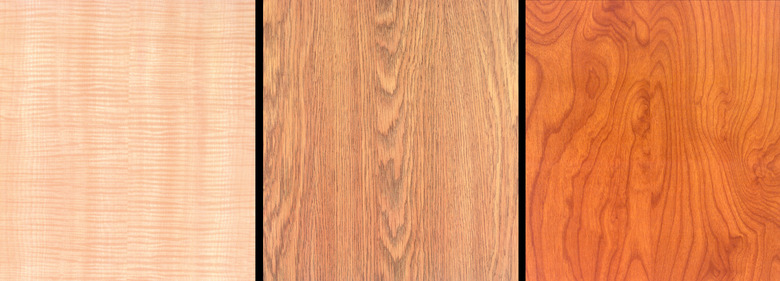Which Wood Is Harder, Oak Or Maple?
Maple is harder than oak. But hardness doesn't always translate into durability. Harder woods can be susceptible to decay, while softer wood resists it. Where you use the hardwood is more important than its density and hardness. Differing sub-species of each variety also play an important role when considering the choices between oak and maple.
Red, White, Hard and Soft
Red, White, Hard and Soft
Oak has two common varieties, red and white. Both can be broken down into 10 or more subspecies. Maple also has two varieties, hard and soft. The soft maple category is separated into another seven varieties. The majority of builders and woodworkers refer to maple and oak generically because two types, red oak and hard maple, are the most commonly used. If you're not sure about what type you're dealing with, refer to the wood's pricing. Soft maple should be priced lower than hard maple. White oak, which is more exclusive than red oak, should be priced higher than red oak.
Hardness and Grain
Hardness and Grain
On the Janka hardness scale — a scale that ranks wood for hardness, hickory is the hardest of all domestic hardwoods, ranking at 1,820. Hard maple ranks 1,450, while red oak ranks 1,290. Poplar ranks 540 on the low end of the scale. Grain patterns also indicate the wood's hardness. Hard maple, with its interlocked, tight grain pattern, resists cracking along grain lines, which also influences water penetration. The open pores and broad grain of red oak allow moisture to penetrate at a higher degree than the glassy, closed pore structure of maple.
Hard Working
Hard Working
Maple assembly techniques typically require first drilling through its hard surface, as nails are prone to bend or break in maple without pilot holes. Also drill pilots in red oak. Other assembly issues include difficulty in laminating or edge gluing maple for panels or doors. Because of its hardness, glue is sometimes expelled from the joint, causing a weak joint. Red oak, with its porous texture, absorbs glue better than maple, and the joints are typically reliable.
Blades and Burns
Blades and Burns
Because of tension in the wood and an inconsistent grain pattern, maple is more likely to twist or warp than oak when cut. Hard maple dulls ordinary woodworking equipment, resulting in burns and sometimes binding. Red oak mills nicely, without excessive dulling of blades and knives and is considered more user-friendly than hard maple. Red oak, because of its coarse and sometimes brittle grain, splinters more readily than maple when cut.
Under Foot
Under Foot
Hard maple is a premier flooring material. Its durable and glassy surface finishes to a high gloss that can take punishment. Maple is commonly used for bowling alleys, dance floors and high-end homes. Red oak flooring is also durable, but with its more prominent grain lines, it's more time-consuming to maintain. Hard maple furniture is less likely to split along grain lines where parts curve on legs or feet than red oak.
Cabinets and Finishing
Cabinets and Finishing
Hard maple cabinets and doors are heavier than a comparable red oak door. Maple doors emit a high-pitched "clack" noise when they close. Red oak doors produce a duller "clunk" sound. Maple is less porous than oak, and even though it's harder, maple doors and cabinets are more susceptible to dents and scratches than oak because of the smooth, uniform surface. Red oak, with its coarse flame pattern, hides scratches better. Maple hardness can lead to stain blotching requiring extra prep work, such as a final sanding with high-grit sandpaper. Red oak absorbs stain at an even rate and is typically free of blotching without extra surface preparation.
Soft Maple
Soft Maple
All of the soft maple varieties are softer than oak. Soft maple is typically reserved for carvings, knobs, handles, veneers and solid guitar bodies. It is also good for moldings and trim and can be used in cabinetry. Oak, because it can chip or splinter, is less desirable for molding, trim or carvings, but many still use oak this way.
Exterior and Decay
Exterior and Decay
Even though they're softer, cypress, cedar, yellow pine, spruce or any other weather-resistant wood is better for exterior decking than maple or oak. Both hard and soft maple are rated as nondurable to perishable, and are susceptible to attack by bugs. Red oak and soft maple are also susceptible to decay. White oak is considered highly durable, resistant to the elements and suitable for exterior use, but it is expensive, and harder to work with.
